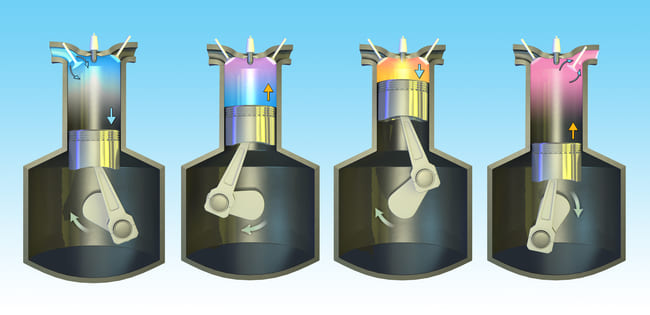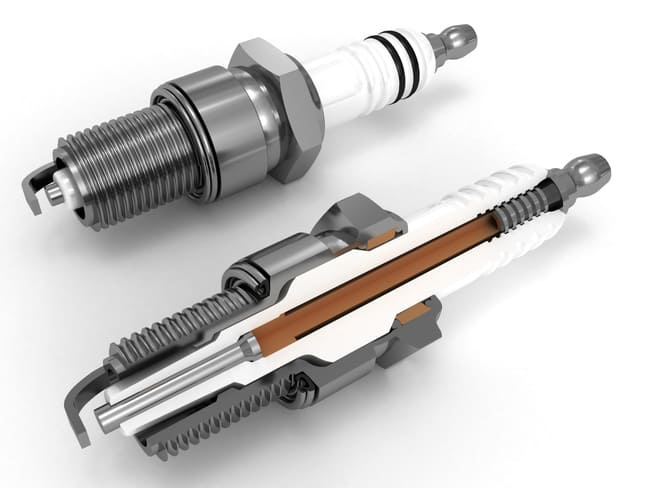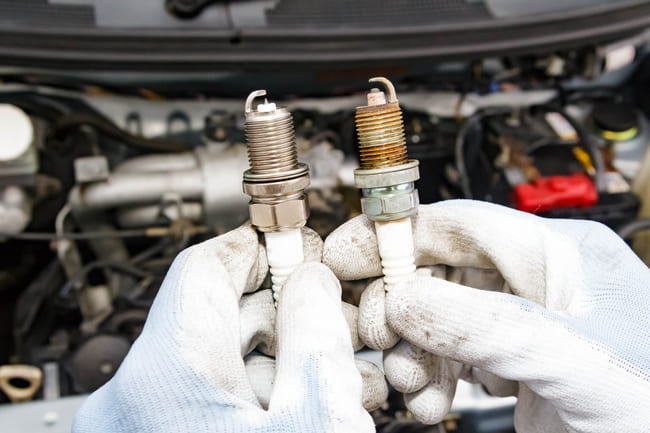
We all have in mind the image of a mechanic who checks, with the hood open, the condition of the spark plugs of a car while holding a greasy rag in his hand. This cliché is still very present because spark plugs remain fragile elements that can wear out quickly and need to be changed at regular intervals. In this article, we will focus on the role of spark plugs, the symptoms of a malfunction, and the replacement of these components.
What is the role of candles?

Spark plugs are essential components of a vehicle's ignition system, which could not start without them. They are found in gasoline engines, and their primary role is to ignite the air-fuel mixture in the combustion chamber by means of a spark that occurs through the phenomenon of electrical breakdown. Spark plugs also play another role: transferring heat out of the combustion chamber. These components are relatively small, and it can be tempting to overlook their function and importance in the powertrain. They are also quite complex.

A spark plug consists of a steel shell or covering. Inside the shell is a center electrode that receives and carries the high-voltage current from the ignition coil. To prevent current leakage, this electrode is insulated with porcelain, and there is just a tiny gap left between the bare tip of the center electrode and the ground electrode. The voltage is so high between the electrodes that it ionizes the air molecules between them, producing the electrical sparks needed to ignite the air-fuel mixture.
How do spark plugs work?
If we expand the scale a little, we have to imagine that the spark plug is at the top of the cylinder head. In the cylinder, the piston first goes down while sucking in a mixture of fuel and air. Then, it goes back up towards the spark plug while compressing the mixture. At the very last point, when the piston is at its maximum stroke or at top dead center (TDC), the spark plug produces a spark and ignites the mixture. The piston is pushed down to create power for the vehicle, then pushed up to expel the exhaust. This process is then repeated to provide the energy needed by the engine. Apart from a few engine configurations that deviate from this pattern, there are logically as many spark plugs as there are cylinders. A four-cylinder car will have four spark plugs, and a six-cylinder car will have six. Furthermore, the spark produced by the spark plugs is possible thanks to the high-voltage current supplied by the ignition coils.
Symptoms of Failure
There are many symptoms that indicate that spark plugs are faulty:
Slow acceleration. When a spark plug starts to fail, you may feel that your vehicle is struggling to accelerate. In this case, while there is a good chance that the spark plug is worn out, it is still best to take it to a garage, as slow acceleration can also be caused by faulty fuel filters, a dirty or clogged fuel injector, or a faulty oxygen sensor.
Fuel consumption is high. A faulty spark plug can lead to increased fuel consumption if the fuel is no longer burned efficiently during the combustion cycle. With wear, it often happens that the gap between the electrodes becomes too close or too far apart, and the spark is then no longer as effective.
The car is having trouble starting. Experienced drivers are often tempted to attribute this problem to a spark plug failure. However, it is best to go to a garage in addition to replacing the spark plug, as different elements can affect the ignition system of an engine.
The engine is misfiring. This is a sign of a problem with the ignition system. It could be a simple sensor, but it could also be caused by the spark plug wire or a fault in the end of the spark plug that connects the wire. In any case, consider asking your mechanic for help as soon as you notice a misfire in the engine.
Replacing spark plugs

If there is any doubt about a spark plug malfunction or when the replacement interval is approaching, it will be necessary to replace the components. In general, it is recommended to replace your spark plugs every 30,000 to 80,000 kilometers (check your vehicle's manual for the specific interval for your model). The parts themselves generally cost between ten and twenty euros. Of course, it is necessary to add the cost of labor if you do not intend to replace them yourself. In total, expect to pay between 100 and 200 euros on average to have all the spark plugs changed in a garage. If you have the skills and motivation, it is entirely possible to do the replacement yourself.
The steps are generally as follows: Prepare your tools. You will need a torque wrench, a spark plug wrench, a ratchet, a vacuum cleaner and/or air blower, a screwdriver, and a clean rag.
Turn off the engine. This may seem obvious, but let the engine cool before working on it and opening the hood to avoid burning yourself.
Locate the spark plugs. Consult your vehicle's manual for their exact location. Verify that the new spark plugs are the same type as the old ones and memorize the location of the components.

Remove the spark plugs. Disconnect the negative terminal of the battery and remove any protective covers if necessary. Take the opportunity to inhale, blow, and clean the area around the spark plugs to prevent dirt and grime from falling into the spark plug socket or engine. Remove the spark plugs one at a time, making sure to mark which wire goes to which spark plug.
Autodoc's tip: If you are still unsure whether you need to replace the spark plugs, you can also proceed to this step to inspect the spark plugs and check that they are not damaged, clogged, or contain foreign objects. If you have a problem with the engine ignition, the issue may indeed come from another component.
Install the new spark plugs. Thread the new spark plugs into the engine by hand, being careful not to strip or overtighten them. You can use a socket extension, and some spark plugs have spark plug caps to hold them in place. Look up the torque specifications for your vehicle and use a torque wrench to tighten the spark plugs. Finally, replace the spark plug caps and reconnect the battery.
Conclusion: It is impossible to run a gasoline engine without spark plugs. These small components, which produce the spark that ignites the air/fuel mixture, are rather fragile, and their wear or malfunction is often the cause of engine problems. It is therefore important to maintain the spark plugs properly, check their condition regularly, and replace them at the recommended interval.



Post a Comment